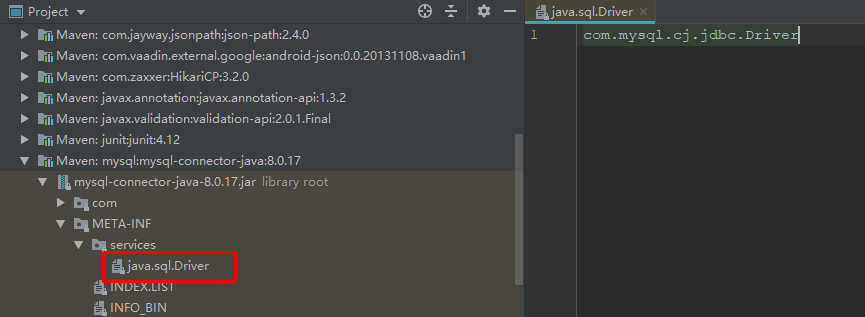SPI机制的原理和应用
SPI ,全称为 Service Provider Interface ,是一种服务发现机制。它通过在ClassPath路径下的 META-INF/services 文件夹查找文件,自动加载文件里所定义的类。
这一机制为很多框架的扩展提供了可能,比如在 Dubbo、JDBC、SpringBoot 中都使用到了SPI机制。虽然他们之间的实现方式不同,但原理都差不多。今天我们就来看看,SPI到底是何方神圣,在众多开源框架中又扮演了什么角色。
一、JDK中的SPI
我们先从JDK开始,通过一个很简单的例子来看下它是怎么用的。
1、小栗子
首先,我们需要定义一个接口,SpiService
public interface SpiService {
void println();
}
复制代码
然后,定义一个实现类,没别的意思,只做打印。
public class SpiServiceImpl implements SpiService {
@Override
public void println() {
System.out.println("-------------");
}
}
复制代码
最后呢,要在resources路径下配置添加一个文件。文件名字是接口的全限定类名,内容是实现类的全限定类名,多个实现类用换行符分隔。

文件内容就是实现类的全限定类名:
com.youyouxunyin.service.impl.SpiServiceImpl 复制代码
2、测试
然后我们就可以通过 ServiceLoader.load 方法拿到实现类的实例,并调用它的方法。
public static void main(String[] args){
ServiceLoader<SpiService> load = ServiceLoader.load(SpiService.class);
Iterator<SpiService> iterator = load.iterator();
while (iterator.hasNext()){
SpiService service = iterator.next();
service.println();
}
}
复制代码
3、源码分析
首先,我们先来了解下 ServiceLoader ,看看它的类结构。
public final class ServiceLoader<S> implements Iterable<S>{
//配置文件的路径
private static final String PREFIX = "META-INF/services/";
//加载的服务类或接口
private final Class<S> service;
//已加载的服务类集合
private LinkedHashMap<String,S> providers = new LinkedHashMap<>();
//类加载器
private final ClassLoader loader;
//内部类,真正加载服务类
private LazyIterator lookupIterator;
}
复制代码
当我们调用 load 方法时,并没有真正的去加载和查找服务类。而是调用了 ServiceLoader 的构造方法,在这里最重要的是实例化了内部类 LazyIterator ,它才是接下来的主角。
private ServiceLoader(Class<S> svc, ClassLoader cl) {
//要加载的接口
service = Objects.requireNonNull(svc, "Service interface cannot be null");
//类加载器
loader = (cl == null) ? ClassLoader.getSystemClassLoader() : cl;
//访问控制器
acc = (System.getSecurityManager() != null) ? AccessController.getContext() : null;
//先清空
providers.clear();
//实例化内部类
LazyIterator lookupIterator = new LazyIterator(service, loader);
}
复制代码
查找实现类和创建实现类的过程,都在 LazyIterator 完成。当我们调用 iterator.hasNext和iterator.next 方法的时候,实际上调用的都是 LazyIterator 的相应方法。
public Iterator<S> iterator() {
return new Iterator<S>() {
public boolean hasNext() {
return lookupIterator.hasNext();
}
public S next() {
return lookupIterator.next();
}
.......
};
}
复制代码
所以,我们重点关注 lookupIterator.hasNext() 方法,它最终会调用到 hasNextService ,在这里返回实现类名称。
private class LazyIterator implements Iterator<S>{
Class<S> service;
ClassLoader loader;
Enumeration<URL> configs = null;
Iterator<String> pending = null;
String nextName = null;
private boolean hasNextService() {
//第二次调用的时候,已经解析完成了,直接返回
if (nextName != null) {
return true;
}
if (configs == null) {
//META-INF/services/ 加上接口的全限定类名,就是文件服务类的文件
//META-INF/services/com.viewscenes.netsupervisor.spi.SPIService
String fullName = PREFIX + service.getName();
//将文件路径转成URL对象
configs = loader.getResources(fullName);
}
while ((pending == null) || !pending.hasNext()) {
//解析URL文件对象,读取内容,最后返回
pending = parse(service, configs.nextElement());
}
//拿到第一个实现类的类名
nextName = pending.next();
return true;
}
}
复制代码
然后当我们调用 next() 方法的时候,调用到 lookupIterator.nextService 。它通过反射的方式,创建实现类的实例并返回。
private S nextService() {
//全限定类名
String cn = nextName;
nextName = null;
//创建类的Class对象
Class<?> c = Class.forName(cn, false, loader);
//通过newInstance实例化
S p = service.cast(c.newInstance());
//放入集合,返回实例
providers.put(cn, p);
return p;
}
复制代码
到这为止,已经获取到了类的实例。
二、JDBC中的应用
我们开头说,SPI机制为很多框架的扩展提供了可能,其实JDBC就应用到了这一机制。
在以前,需要先设置数据库驱动的连接,再通过 DriverManager.getConnection 获取一个 Connection 。
String url = "jdbc:mysql:///consult?serverTimezone=UTC";
String user = "root";
String password = "root";
Class.forName("com.mysql.jdbc.Driver");
Connection connection = DriverManager.getConnection(url, user, password);
复制代码
而现在,设置数据库驱动连接,这一步骤就不再需要,那么它是怎么分辨是哪种数据库的呢?答案就在SPI。
1、加载
我们把目光回到 DriverManager 类,它在静态代码块里面做了一件比较重要的事。很明显,它已经通过SPI机制, 把数据库驱动连接初始化了。
public class DriverManager {
static {
loadInitialDrivers();
println("JDBC DriverManager initialized");
}
}
复制代码
具体过程还得看 loadInitialDrivers ,它在里面查找的是Driver接口的服务类,所以它的文件路径就是:
META-INF/services/java.sql.Driver
private static void loadInitialDrivers() {
AccessController.doPrivileged(new PrivilegedAction<Void>() {
public Void run() {
//很明显,它要加载Driver接口的服务类,Driver接口的包为:java.sql.Driver
//所以它要找的就是META-INF/services/java.sql.Driver文件
ServiceLoader<Driver> loadedDrivers = ServiceLoader.load(Driver.class);
Iterator<Driver> driversIterator = loadedDrivers.iterator();
try{
//查到之后创建对象
while(driversIterator.hasNext()) {
driversIterator.next();
}
} catch(Throwable t) {
// Do nothing
}
return null;
}
});
}
复制代码
那么,这个文件哪里有呢?我们来看MySQL的jar包,就是这个文件,文件内容为: com.mysql.cj.jdbc.Driver 。

2、创建实例
上一步已经找到了MySQL中的 com.mysql.cj.jdbc.Driver 全限定类名,当调用next方法时,就会创建这个类的实例。它就完成了一件事,向 DriverManager 注册自身的实例。
public class Driver extends NonRegisteringDriver implements java.sql.Driver {
static {
try {
//注册、调用DriverManager类的注册方法
//往registeredDrivers集合中加入实例
DriverManager.registerDriver(new Driver());
} catch (SQLException var1) {
throw new RuntimeException("Can't register driver!");
}
}
}
复制代码
3、创建Connection
DriverManager.getConnection() 方法就是创建连接的地方,它通过循环已注册的数据库驱动程序,调用其connect方法,获取连接并返回。
private static Connection getConnection(String url, Properties info, Class<?> caller) throws SQLException {
//registeredDrivers中就包含com.mysql.cj.jdbc.Driver实例
for(DriverInfo aDriver : registeredDrivers) {
if(isDriverAllowed(aDriver.driver, callerCL)) {
try {
//调用connect方法创建连接
Connection con = aDriver.driver.connect(url, info);
if (con != null) {
return (con);
}
}catch (SQLException ex) {
if (reason == null) {
reason = ex;
}
}
} else {
println("skipping: " + aDriver.getClass().getName());
}
}
}
复制代码
4、扩展
既然我们知道JDBC是这样创建数据库连接的,我们能不能再扩展一下呢?如果我们自己也创建一个 java.sql.Driver 文件,自定义实现类MySQLDriver,那么,在获取连接的前后就可以动态修改一些信息。
还是先在项目resources下创建文件,文件内容为自定义驱动类 com.youyouxunyin.driver.MySQLDriver

我们的 MySQLDriver 实现类,继承自 MySQL中的NonRegisteringDriver ,还要实现 java.sql.Driver 接口。这样,在调用connect方法的时候,就会调用到此类,但实际创建的过程还靠MySQL完成。
public class MySQLDriver extends NonRegisteringDriver implements Driver{
static {
try {
DriverManager.registerDriver(new MySQLDriver());
} catch (SQLException e) {
e.printStackTrace();
}
}
public MySQLDriver() throws SQLException {}
@Override
public Connection connect(String url, Properties info) throws SQLException {
System.out.println("准备创建数据库连接.url:"+url);
System.out.println("JDBC配置信息:"+info);
info.setProperty("user", "root");
Connection connection = super.connect(url, info);
System.out.println("数据库连接创建完成!"+connection.toString());
return connection;
}
}
复制代码
这样的话,当我们获取数据库连接的时候,就会调用到这里。
--------------------输出结果---------------------
准备创建数据库连接.url:jdbc:mysql:///consult?serverTimezone=UTC
JDBC配置信息:{user=root, password=root}
数据库连接创建完成!com.mysql.cj.jdbc.ConnectionImpl@7cf10a6f
复制代码
三、SpringBoot中的应用
Spring Boot提供了一种快速的方式来创建可用于生产环境的基于Spring的应用程序。它基于Spring框架,更倾向于约定而不是配置,并且旨在使您尽快启动并运行。
即便没有任何配置文件,SpringBoot的Web应用都能正常运行。这种神奇的事情,SpringBoot正是依靠自动配置来完成。
说到这,我们必须关注一个东西: SpringFactoriesLoader ,自动配置就是依靠它来加载的。
1、配置文件
SpringFactoriesLoader 来负责加载配置。我们打开这个类,看到它加载文件的路径是: META-INF/spring.factories

笔者在项目中搜索这个文件,发现有4个Jar包都包含它:
spring-boot-2.1.9.RELEASE.jar spring-beans-5.1.10.RELEASE.jar spring-boot-autoconfigure-2.1.9.RELEASE.jar mybatis-spring-boot-autoconfigure-2.1.0.jar
那么它们里面都是些啥内容呢?其实就是一个个接口和类的映射。在这里笔者就不贴了,有兴趣的小伙伴自己去看看。
比如在SpringBoot启动的时候,要加载所有的 ApplicationContextInitializer ,那么就可以这样做:
SpringFactoriesLoader.loadFactoryNames(ApplicationContextInitializer.class, classLoader)
2、加载文件
loadSpringFactories 就负责读取所有的 spring.factories 文件内容。
private static Map<String, List<String>> loadSpringFactories(@Nullable ClassLoader classLoader) {
MultiValueMap<String, String> result = cache.get(classLoader);
if (result != null) {
return result;
}
try {
//获取所有spring.factories文件的路径
Enumeration<URL> urls = lassLoader.getResources("META-INF/spring.factories");
result = new LinkedMultiValueMap<>();
while (urls.hasMoreElements()) {
URL url = urls.nextElement();
//加载文件并解析文件内容
UrlResource resource = new UrlResource(url);
Properties properties = PropertiesLoaderUtils.loadProperties(resource);
for (Map.Entry<?, ?> entry : properties.entrySet()) {
String factoryClassName = ((String) entry.getKey()).trim();
for (String factoryName : StringUtils.commaDelimitedListToStringArray((String) entry.getValue())) {
result.add(factoryClassName, factoryName.trim());
}
}
}
cache.put(classLoader, result);
return result;
}
catch (IOException ex) {
throw new IllegalArgumentException("Unable to load factories from location [" +
FACTORIES_RESOURCE_LOCATION + "]", ex);
}
}
复制代码
可以看到,它并没有采用JDK中的SPI机制来加载这些类,不过原理差不多。都是通过一个配置文件,加载并解析文件内容,然后通过反射创建实例。
3、参与其中
假如你希望参与到 SpringBoot 初始化的过程中,现在我们又多了一种方式。
我们也创建一个 spring.factories 文件,自定义一个初始化器。
org.springframework.context.ApplicationContextInitializer=com.youyouxunyin.config.context.MyContextInitializer

然后定义一个MyContextInitializer类
public class MyContextInitializer implements ApplicationContextInitializer {
@Override
public void initialize(ConfigurableApplicationContext configurableApplicationContext) {
System.out.println(configurableApplicationContext);
}
}
复制代码
- 本文标签: Spring Boot UI 实例 Connection root bean 数据库 CTO 构造方法 mybatis ACE 源码 id 配置 URLs tk provider web Service https HashMap 代码 list Word classpath 希望 map parse UTC dubbo java Action ip consul IDE value http 测试 IO sql 解析 JDBC 开源 spring Property springboot 数据 key src ssl cache cat App 类加载器 final mysql Security db
- 版权声明: 本文为互联网转载文章,出处已在文章中说明(部分除外)。如果侵权,请联系本站长删除,谢谢。
- 本文海报: 生成海报一 生成海报二











![[HBLOG]公众号](https://www.liuhaihua.cn/img/qrcode_gzh.jpg)

